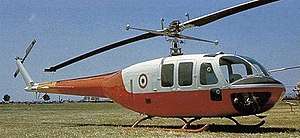Agusta-Bell AB.102
| AB.102 | |
|---|---|
 | |
| Role | Utility helicopter |
| Manufacturer | Agusta |
| First flight | 3 February 1959 |
| Introduction | 1961 |
| Primary user | Elivie |
| Number built | 1+2 |
| Developed from | Bell 48 |
The Agusta AB.102 was an Italian helicopter produced in small numbers in the early 1960s. The aircraft was based on the mechanical components of a Bell 48 that Agusta incorporated into an all-new, streamlined fuselage. The first flight was on 3 February 1959 and the prototype was exhibited at that year's Paris Air Show in faux military colours. Only two production examples were built, operated by Elivie in a regular air service between Turin and Milan from 1961. However, the advent of turbine-powered helicopters in the 1960s soon rendered the AB.102 obsolete.
Operators
Specifications
Data from Jane's All The World's Aircraft 1961–62[3]
General characteristics
- Crew: 1
- Capacity: 7-9 passengers or 880 kg (1,940 lb) cargo or 4 stretchers and 1 attendant
- Length: 12.73 m (41 ft 9 in)
- Rotor diameter: 14.50 m (47 ft 7 in)
- Height: 3.23 m (10 ft 7 in)
- Disc area: 165.1 m² (1,778 sq ft)
- Empty weight: 1,810 kg (3,990 lb)
- Loaded weight: 2,725 kg (6,000 lb)
- Max. takeoff weight: 3,025 kg (6,670 lb)
- Powerplant: 1 × Pratt & Whitney R-1340-S1H4 radial engine, 447 kW (600 hp)
Performance
- Maximum speed: 174 km/h (94 knots, 108 mph)
- Cruise speed: 160 km/h (87 knots, 100 mph)
- Range: 350 km (191 nmi, 220 mi)
- Service ceiling: 3,900 m (12,800 ft)
- Rate of climb: 5.6 m/s (1,100 ft/min)
See also
Related development
References
| Wikimedia Commons has media related to Agusta. |
- ↑ "WORLD AIRLINE SURVEY 1963". flightglobal.com. Retrieved 18 October 2014.
- ↑ "World Helicopter Market 1967". flightglobal.com. Retrieved 18 October 2014.
- ↑ Taylor 1961, p. 98.
- Taylor, John W. R. (1961). Jane's All The World's Aircraft 1961–62. London: Sampson Low, Marston & Company.
- Taylor, Michael J. H. (1989). Jane's Encyclopedia of Aviation. London: Studio Editions. p. 40.
- Simpson, R. W. (1998). Airlife's Helicopters and Rotorcraft. Ramsbury: Airlife Publishing. p. 36.
This article is issued from
Wikipedia.
The text is licensed under Creative Commons - Attribution - Sharealike.
Additional terms may apply for the media files.